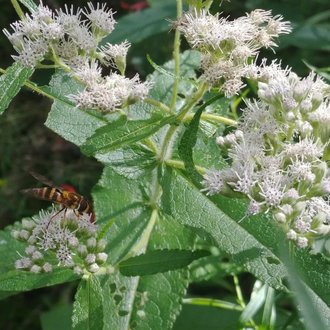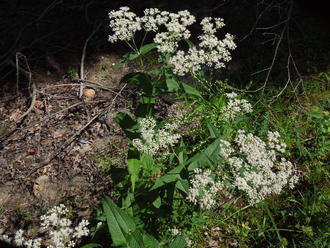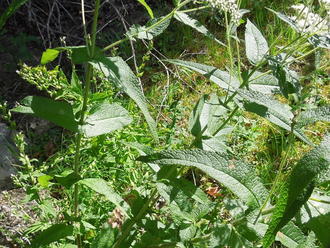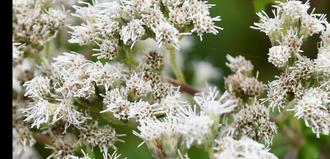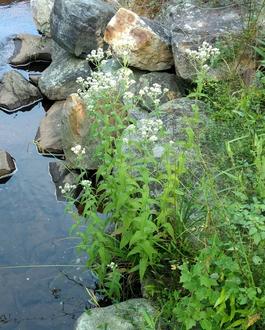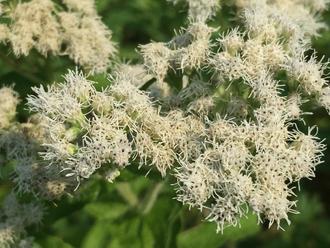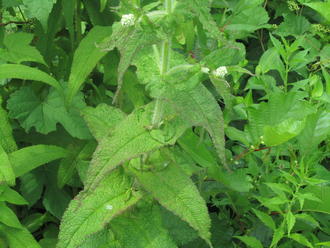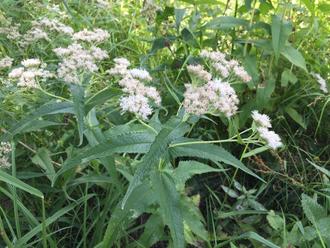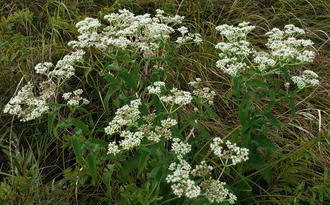Common Boneset (Eupatorium perfoliatum L.)
↑Summary
Common boneset is a distinctive plant characterized by its leaves that fuse at the base, creating an interesting appearance in which the stem appears to come up through a diamond-shaped leaf.
↑Range - Expand
| Legend | Color |
| Native | |
| Native or Not Present |
This tentative map is based on our own research. It may have limited data on Canada and/or Mexico, and there is some subjectivity in our assignment of plants as introduced vs. expanded. Read more in this blog post.
Although this plant occurs somewhere in each of these regions, it may only occur in a small part of some or all of them.
↑Description & Identification
This plant is visually distinctive due to its fused leaves, and as such is easily distinguished from other similar-looking species.
↑Habitat
Found primarily in sunny conditions on wetland margins, including shores of lakes and rivers, or margins of marshes or swamps. Also found in sunny openings in floodplains, poorly-drained areas in wet prairies. Also found in wet anthropogenic habitats, including roadside ditches and drainage ponds.
Requires soil that is consistently moist, and tolerates temporary flooding and waterlogged soil, but does not grow in areas with persistent standing water. Prefers soil with a signficant content of organic matter. Found in full to partial sun.
↑Life Cycle
This species is a perennial. Seedlings establish on exposed soil, often following some sort of disturbance. Germination is triggered by light and warm temperatures, and happens in late spring to summer, when daytime temperatures reach 70-85°F.
Established plants spread by short rhizomes, forming clumps on favorable sites; major nodes form a stem and a fibrous root system. Stems usually do not branch until close to the inflorescence.
Plants flower in late summer to early fall, and flowers develop into clusters of small dry seeds attached to hair-like bristles, which aid in wind dispersal. Germination rates are low, although some seeds typically do germinate in the next growing season if conditions are suitable. We could not find information on how long this species can persist in the seed bank, but its presence has been recorded in soil seed banks, and it is likely it persists at least for a few years.
↑Uses
Common boneset is sometimes used as a garden or landscaping plant, particularly in native plant gardens. Can be grown on drier ground than it would naturally occur, but plants can become stressed in dry weather. In gardens it is generally harder to grow than E. serotinum or E. altissimum due to its lower drought-tolerance.
↑Related Plants
There are numerous other Eupatorium sp. with overlapping ranges in most parts of this plant's range. In addition, there are plants of other genera in the Eupatorium tribe, also closely related.
↑Links & External Resources
• Eupatorium perfoliatum (Common Boneset) | Illinois Wildflowers (About This Site)
• Eupatorium perfoliatum (Common Boneset) | USDA PLANTS Database (About This Site)
• Eupatorium perfoliatum | Go Botany (About This Site)
• Eupatorium perfoliatum (American Boneset) | Missouri Botanical Garden Plant Finder (About This Site)
• Eupatorium perfoliatum | Biota of North America Project (BONAP) (About This Site)
• Eupatorium perfoliatum | NatureServe Explorer (About This Site)
• Eupatorium perfoliatum | Flora of North America (About This Site)
• Eupatorium perfoliatum | Missouri Plants (About This Site)
• Common Boneset | Maryland Biodiversity Project (About This Site)
• Eupatorium perfoliatum (Common Boneset) | Minnesota Wildflowers (About This Site)
• Eupatorium perfoliatum L. (Boneset, Common Boneset) | Digital Atlas of the Virginia Flora (About This Site)



